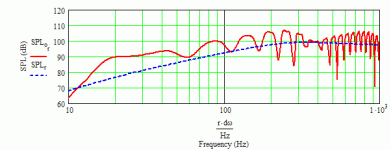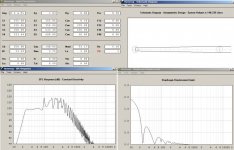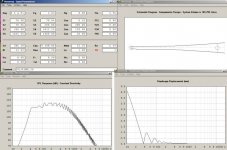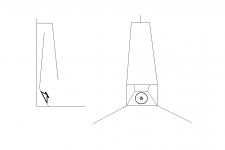Re: Tom Danley's Tapped Horn Patent
I've wondered about this also since it's acoustically no different than any other driver-in-mouth BLH and why I'm able to design these simple pipe horns using MJK's MathCad BLH worksheet. For example, here's the BLH sim of the Beyma Hornresp 'TH' I recently posted:
GM
David McBean said:
Surely there would be no problem in people building and selling "William Cowan type" tapped horns, if they so desire?
I've wondered about this also since it's acoustically no different than any other driver-in-mouth BLH and why I'm able to design these simple pipe horns using MJK's MathCad BLH worksheet. For example, here's the BLH sim of the Beyma Hornresp 'TH' I recently posted:
GM
Attachments
Hi GM, thats an interesting twist on my idea, i appreciate the new input. Regarding my room, its about 6,6 * 5,5 meters, with the lowest resonance at about 26hz. If i setup my woofers to cancel the lower room modes, there is no room gain above about 20hz. If i choose corner placement, i get a boost at some low frequencies but also alot of notches, allways depending on where the listener is - my room is really a bad case. This is why i think maximally flat in combination with proper placement to cancel some room modes will work better.
I made a spectrum analyzer survey about my music and i found out, that while 30hz bass is quite common, 20hz is rare and mostly due to vinyl rumbling, strange samples etc. I only found two records, that use a <30hz tone as a bassline. From this point of view, it doenst do harm to use a 30hz horn. Most of my music drops like a rock below 30hz, some even at 40hz. It seems like many mastering engineers like to have a highpass there.
Hi tb46, also much thanks to you, for the idea. I didnt know i could get such a flat <100hz response, i tried and found no parameter set for it. If i only could cross my mains so low. Well i could do this, but that would rob me of 15db headroom
I made a spectrum analyzer survey about my music and i found out, that while 30hz bass is quite common, 20hz is rare and mostly due to vinyl rumbling, strange samples etc. I only found two records, that use a <30hz tone as a bassline. From this point of view, it doenst do harm to use a 30hz horn. Most of my music drops like a rock below 30hz, some even at 40hz. It seems like many mastering engineers like to have a highpass there.
Hi tb46, also much thanks to you, for the idea. I didnt know i could get such a flat <100hz response, i tried and found no parameter set for it. If i only could cross my mains so low. Well i could do this, but that would rob me of 15db headroom

It just ain’t fair …
Without Tom Danley, there wouldn’t even be a Tapped Horn … but that doesn’t mean Tom will get a patent. After examining his European patent application, and reading up on the Jensen Transflex from the early 50’s and the work by Klayman in the 90’s, I’m not sure what’s left for Tom to patent. David McBean credits Peter Tappan with analyzing the Transflex back in ’58 and David’s HornResp program uses Tappan’s analysis to model the Tapped Horn.
In the mean time, there’s absolutely nothing preventing you from making a few Tapped Horns, and even selling them ... but be warned, if you set up production, and sell a bunch, and Tom does get his patent, he may come around asking for a share.
Without Tom Danley, there wouldn’t even be a Tapped Horn … but that doesn’t mean Tom will get a patent. After examining his European patent application, and reading up on the Jensen Transflex from the early 50’s and the work by Klayman in the 90’s, I’m not sure what’s left for Tom to patent. David McBean credits Peter Tappan with analyzing the Transflex back in ’58 and David’s HornResp program uses Tappan’s analysis to model the Tapped Horn.
In the mean time, there’s absolutely nothing preventing you from making a few Tapped Horns, and even selling them ... but be warned, if you set up production, and sell a bunch, and Tom does get his patent, he may come around asking for a share.
Hello!
And what about Robert G.Pruden Patent US 3,047,090 granted to him July 31, 1962, filled May 7, 1958.
Go to:
http://free.patentfetcher.com/Patent-Fetcher.php?submit=Fetch&PN=3,047,090
and type 3,047,090.
Isn't it a TH?
Regards, Paulo.
And what about Robert G.Pruden Patent US 3,047,090 granted to him July 31, 1962, filled May 7, 1958.
Go to:
http://free.patentfetcher.com/Patent-Fetcher.php?submit=Fetch&PN=3,047,090
and type 3,047,090.
Isn't it a TH?
Regards, Paulo.
And what about Robert G.Pruden Patent US 3,047,090 granted to him July 31, 1962, filled May 7, 1958.
Anyone want to expound on section II, specifically subsection (b)2? What I am curious about is the use of tuning holes, and his assertion that he ends up with "two separate low frequency horns".
Has anyone read the document he cites, "article by W.P. Mason, Bell System Technical Journal, volume 6 page 258 (1927)" regarding "Branch Transmission Theory of Acoustical Filtration"?
In my opinion, TD most likely invented the TH, but, it may be that it had been invented previously in all but name only.
Paul
Re: Tom Danley's Tapped Horn Patent
I have no idea what makes Tom's aplication patentable. However, I have come to learn over the years that anything and everything is patentable. You just have to convince the Patent Office that it is unique enough. I have seen cases were just describing the same thing in a different way makes it patentable. I'm not saying it is right, but it is legal. There is always a difference between what is right, wrong, and what is legal. The concern I have is patent law is retroactive from the date of the application. If the patent is granted, then all sales from the date of Tom's patent application is fair game for legal action.
Rgs, JLH
David McBean said:
Hi JLH,
Just out of interest, do you know what aspect of tapped horn technology Tom Danley has a patent for? I must confess that I am a bit surprised that a patent would be granted - the basic principles of tapped horns have been known and well understood for at least fifty years, to my knowledge.
I guess my real question is - what is it about Tom's tapped horns that make them so unique, thereby justifying the granting of an exclusive patent?
Surely there would be no problem in people building and selling "William Cowan type" tapped horns, if they so desire?
For the record, I have absolutely no intention of building and selling tapped horns myself.
Thanks in anticipation for any further information.
Kind regards,
David
I have no idea what makes Tom's aplication patentable. However, I have come to learn over the years that anything and everything is patentable. You just have to convince the Patent Office that it is unique enough. I have seen cases were just describing the same thing in a different way makes it patentable. I'm not saying it is right, but it is legal. There is always a difference between what is right, wrong, and what is legal. The concern I have is patent law is retroactive from the date of the application. If the patent is granted, then all sales from the date of Tom's patent application is fair game for legal action.
Rgs, JLH
I don't see any reason why a triangular version would not work...it would blend into the room much better. Higher WAF.
I believe somewhere in Tom's patent there is mention of different shapes being covered,as long as the operating principle is the same.
Last year on a slow night at work I had calculated the dimensions for a triangular version of my TH,but have no idea where it is now....
The only difference was one angled piece for the inner baffle,and the outside was not tapered.
I believe somewhere in Tom's patent there is mention of different shapes being covered,as long as the operating principle is the same.
Last year on a slow night at work I had calculated the dimensions for a triangular version of my TH,but have no idea where it is now....
The only difference was one angled piece for the inner baffle,and the outside was not tapered.
Re: Re: Tom Danley's Tapped Horn Patent
Hi JLH,
Thanks for the additional information. If I understand things correctly now, it would seem that Tom has applied for a patent relating to tapped horn technology, but that no patent has actually yet been granted.
Further to your comment above, it is interesting to note that for a patent application filed in the United States Patent and Trademark Office, “the protection afforded by a patent does not start until the actual grant of the patent”. [Source: USPTO website].
Don (Snyder) refers to "his European patent application". Perhaps this means that Tom can indeed take retrospective action, provided that the patent is granted by an authority other than the USPTO.
Nevertheless, I am still struggling to find anything in the William Cowan tapped horn design, for example, that I believe Tom could protect via a patent. The Robert Pruden patent document referenced by Paulo would seem to be further evidence that the configuration has been well and truly utilised previously, and that "prior art" definitely exists.
I guess though, we should really leave it to the Patent Office to decide... .
.
Kind regards,
David
JLH said:The concern I have is patent law is retroactive from the date of the application. If the patent is granted, then all sales from the date of Tom's patent application is fair game for legal action.
Hi JLH,
Thanks for the additional information. If I understand things correctly now, it would seem that Tom has applied for a patent relating to tapped horn technology, but that no patent has actually yet been granted.
Further to your comment above, it is interesting to note that for a patent application filed in the United States Patent and Trademark Office, “the protection afforded by a patent does not start until the actual grant of the patent”. [Source: USPTO website].
Don (Snyder) refers to "his European patent application". Perhaps this means that Tom can indeed take retrospective action, provided that the patent is granted by an authority other than the USPTO.
Nevertheless, I am still struggling to find anything in the William Cowan tapped horn design, for example, that I believe Tom could protect via a patent. The Robert Pruden patent document referenced by Paulo would seem to be further evidence that the configuration has been well and truly utilised previously, and that "prior art" definitely exists.
I guess though, we should really leave it to the Patent Office to decide...
Kind regards,
David
aceinc said:In my opinion, TD most likely invented the TH, but, it may be that it had been invented previously in all but name only.
Hi Paul,
In that case, the best that Tom could probably hope for is to be able to register "Tapped Horn" as an exclusive trademark.
Kind regards,
David
Hi David, all
I have produced a fair number of patents for things I have invented in the past for the companies I worked for but I would not say I have that good of a handle on the patent process, yet would toss in a few thoughts.
If you do a patent search on my name as the inventor, you will see that what I have done is generally unlike other things of the day. I mostly let measurements and observation guide my direction and being a DIY’r at heart, I have been accused of thinking out side the box, what ever that is.
The idea for the Tapped horn came from thinking about the reflected wave present at the upper limit of a driver mounted in the side of a horn like a Unity or Synergy horn.
I thought “what if I substituted a source with the opposite phase” (back side of the driver). Already having a way to model the Unity and Synergy horns, I simply altered the setup a bit and worked on and off for a week or two until I had an alignment worth trying.
Well after I had a number built and a design routine figured out, I was sent a copy of the Jensen Transflex design by a speaker historian I know and thought wow, how weird and similar, if they only had made it a horn and had the proportions right it would have worked well..
What matters to the patent office is if one can show something is novel and new, has advantages over prior art etc.
Also, dimensions matter in some designs, for example an “open back” cabinet, a “Bass Reflex” cabinet, “Back loaded horn” and Vented box all have an identical basic topology yet by using different physical / acoustic dimensions, yet they remain different things. The devil is in the details.
So it is here, when the acoustic dimensions are “right” in the Tapped horn and when compared to current art, the Tapped horn can outperform either a vented box or conventional horn of the same size and has proven it self in the Pro-sound market.
If that performance had been part of any of the previous configurations, they would be ubiquitous, like a vented box is now.
All that aside, will the patent office agree with the assessment of prior art and “new” argument?, I haven’t a clue but have no choice but to try and see, especially now that I am on my own.
Some patent applications were accepted w/o a fight, some are never accepted, all I can say is its part of the legal system and apparently mere mortals are not really suppose to understand the process or language.
Best,
Tom Danley
I have produced a fair number of patents for things I have invented in the past for the companies I worked for but I would not say I have that good of a handle on the patent process, yet would toss in a few thoughts.
If you do a patent search on my name as the inventor, you will see that what I have done is generally unlike other things of the day. I mostly let measurements and observation guide my direction and being a DIY’r at heart, I have been accused of thinking out side the box, what ever that is.
The idea for the Tapped horn came from thinking about the reflected wave present at the upper limit of a driver mounted in the side of a horn like a Unity or Synergy horn.
I thought “what if I substituted a source with the opposite phase” (back side of the driver). Already having a way to model the Unity and Synergy horns, I simply altered the setup a bit and worked on and off for a week or two until I had an alignment worth trying.
Well after I had a number built and a design routine figured out, I was sent a copy of the Jensen Transflex design by a speaker historian I know and thought wow, how weird and similar, if they only had made it a horn and had the proportions right it would have worked well..
What matters to the patent office is if one can show something is novel and new, has advantages over prior art etc.
Also, dimensions matter in some designs, for example an “open back” cabinet, a “Bass Reflex” cabinet, “Back loaded horn” and Vented box all have an identical basic topology yet by using different physical / acoustic dimensions, yet they remain different things. The devil is in the details.
So it is here, when the acoustic dimensions are “right” in the Tapped horn and when compared to current art, the Tapped horn can outperform either a vented box or conventional horn of the same size and has proven it self in the Pro-sound market.
If that performance had been part of any of the previous configurations, they would be ubiquitous, like a vented box is now.
All that aside, will the patent office agree with the assessment of prior art and “new” argument?, I haven’t a clue but have no choice but to try and see, especially now that I am on my own.
Some patent applications were accepted w/o a fight, some are never accepted, all I can say is its part of the legal system and apparently mere mortals are not really suppose to understand the process or language.
Best,
Tom Danley
Tom:
What you have done then would be analagous to the Wright Brothers in that there were plenty of gliders and attempts at motorized aeronautical vehicles with wings of various geometries before Kitty Hawk. They however used a more rigorous scientific approach to trying to determine why and how these wing shapes worked, or didn't.
Paul
What you have done then would be analagous to the Wright Brothers in that there were plenty of gliders and attempts at motorized aeronautical vehicles with wings of various geometries before Kitty Hawk. They however used a more rigorous scientific approach to trying to determine why and how these wing shapes worked, or didn't.
Paul
JLH said:
...I have come to learn over the years that anything and everything is patentable.
Rgs, JLH
Yes, it seems that _anyting_ can get approved at the US patents office. For example we Olsons (in)famous patent on swinging (6,368,227)
That's rich...
but just so you know I happen to hold the patent for falling off of a swing. Say I wonder if anybody has the patent on twisting the chains up like a rubber band on a toy airplane then letting go and spinning around and around and around and ohhh I feel sick...
but just so you know I happen to hold the patent for falling off of a swing. Say I wonder if anybody has the patent on twisting the chains up like a rubber band on a toy airplane then letting go and spinning around and around and around and ohhh I feel sick...
- Home
- Loudspeakers
- Subwoofers
- Collaborative Tapped horn project



